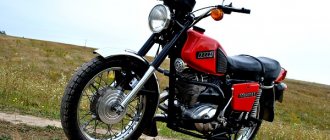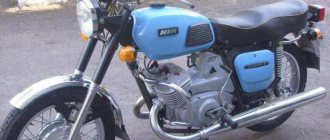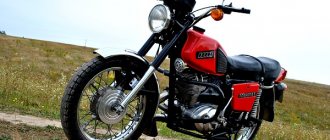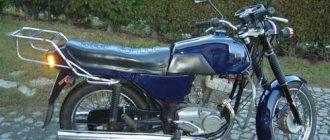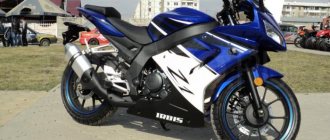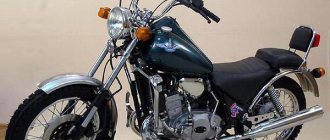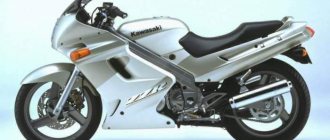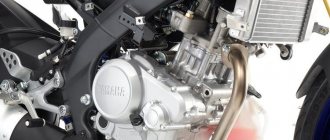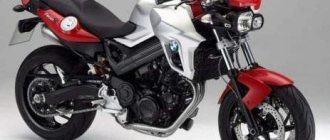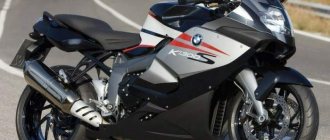Story
The IZH Jupiter-4 road motorcycle was produced by the Izhevsk engineering plant from 1980 to 1985. In the production race, the engineering company decided to increase the maximum speed of the motorcycle by upgrading the engine. It is not surprising that the production of the Czech Jawa did not suffer any losses.
At that time, Jawa was Izhey’s main competitor. The elegant Czech motorcycle was superior to the Jupiter with a more sophisticated design. Czech engineers have created a faster, more economical and, most importantly, reliable two-wheeled vehicle. Despite this, the domestic IZH was in considerable demand within the country. Over five years of production, more than a million copies of IZH Jupiter-4 and IZH Jupiter-4k were produced and sold. The latter is distinguished by the presence of a side trailer (stroller). After 1985, a new series of domestic motorcycles, IZH Jupiter-5, was launched into production.
Motorcycle IZH Jupiter 3 - characteristics and features
Among domestic middle-class motorcycles, the leader was the IZH Jupiter series.
A special feature of these motorcycles was a two-cylinder engine, which provided some advantage over another Izhevsk machine-building motorcycle.
Serial production of IZH Jupiter began in 1961; this series included five generations and was produced until 2008.
Now let’s look at the third generation model “IZH Jupiter 3”.
- Description of design
- Specifications
- Approximate cost
- Photo gallery
- Video
It was no coincidence that this model was chosen, since at one time completely redesigned engines began to be installed on these motorcycles, which had significantly increased power compared to their predecessors , so IZH Jupiter 3 was already the first model of a new generation of motorcycles.
It should also be noted that this motorcycle was produced for a very long time - 10 years (from 1971 to 1981) and in this indicator only IZH-Jupiter 5 surpasses it.
Technical characteristics, recommendations
Let's look at the qualitative data of the IZH Jupiter-4 motorcycle. Its characteristics are as follows:
- engine power – 28 hp. With.;
- maximum speed – 130 km/h;
- weight – 160 kilograms (with equipment);
- maximum engine speed – 7800 rpm;
- ground clearance - 130 mm;
- Gearbox 4-speed, semi-automatic;
- multi-plate clutch system in an oil bath;
- fuel type - air-gasoline mixture (Au - 76, Au - 80 together with oil);
- two-cylinder carburetor two-stroke.
Since the IZH Jupiter-4 ignition has a cam, it is important to set it up reliably and occasionally inspect it. The process of setting the timing of the spark is described below. It is important that the generator armature is installed level and that the bolt that attaches it to the crankshaft is tightened tightly.
From time to time it doesn't hurt to inspect the ignition elements. Soviet engineers did not provide for the machine to operate uninterruptedly in the presence of water or humidity. Therefore, if problems arise with the spark, you need to inspect the ignition contacts for oxidation.
It would not hurt to carry out similar procedures with other electrical systems and contacts.
How did the motorcycle from the USSR IZH Planet 5 differ from IZH Planet 4
Back in 1962, the first motorcycle called IZH Planet appeared on the assembly line of the Izhevsk Motorcycle Plant. This was the first model of the legendary Planet series, which ended in 2008 with the IZH Planet 5 model. Quite a long history of 46 years, which gave the USSR a number of excellent motorcycles. And if the first motorcycle, for obvious reasons, was very different from the latest model, then the difference between the 4th and 5th models may be minimal, we’ll look at that today.
Let's draw a line between the IZH Planet 4 and IZH Planet 5 models. Well, apart from the year of manufacture, for Planet 4 it is 1983, and for 5 1987 they are distinguished, of course, by their appearance. With the same single-cylinder engine, they have different numbers of exhaust pipes, the Planet 4 has two, and the Planet 5 has one pipe installed. The engine power itself was also different, the 4 had a 20 horsepower engine, the 5 had a 22 hp unit. On the fifth model, the dashboard has been changed, in which the ignition switch is made separately, and on the 4th it is located next to the motorcycle indicator lamps.
The difference between Jupiter IZH-4 and its predecessor, IZH Yu3
Actually, the “fourth” is considered the most successful and reliable among the Jupiter generation. It differs from its predecessor, IZH Jupiter-3, in having a more powerful power unit (the power of IZH Jupiter-4 is 28 horsepower, while Jupiter-3 produces only 25). Engineers managed to increase engine power due to a new cylinder design. In the new cylinders, the designers provided wider purge windows. Due to this, the maximum crankshaft speed has increased (7800 rpm).
But, unfortunately, in the pursuit of money, the plant overlooked the issue of quality and reliability of the design. Years later, IZH Jupiter-4 showed its weaknesses. Namely, the design of the cylinders did not provide for higher strength and reliability. The engine life has been significantly reduced due to the increase in purge windows.
In addition to modernizing the cylinder-piston group, Izhmash specialists provided modern 12-volt electrical equipment for the new Jupiter model. This modernization gave the IZH Yu-4 a brighter light and a more powerful ignition spark compared to the 6-volt previous models.
The first material about editorial tests of the IZH-Jupiter-4 motorcycle with a sidecar (“Behind the Wheel,” 1981, No. 11) talked about what distinguishes this model from the previous ones, and about the beginning of the run-in. Now the motorcycle has covered about 7,000 kilometers, and there is an opportunity to evaluate its driving performance and the design of some components.
When the speedometer showed just over 6,000 kilometers and the engine was running perfectly, we began to be bothered by a noise, the source of which was somewhere under the left crankcase cover. The noise is not loud, but quite unpleasant (note that, unfortunately, this sound is well known to many Jupiter fans). The assumption arose that the fault should be looked for in the motor chain drive.
When the crankcase cover was removed at a service station in Zagorsk, the diagnosis was confirmed: the motor transmission chain was very stretched. Willy-nilly, I had to replace it with a new one. This fact, naturally, cannot but upset us, since the mileage of the motorcycle, frankly speaking, is not enough to justify such replacements of parts.
However, our mood was brightened by the quality of the crankcase and its cover with seals. Before disassembly, there were no traces of oil at their junction - no greasy stains familiar to all motorcyclists, no leaks, which gave rise to one of the local wits to joke: “Now you’ll see - there’s no oil there!” But there was exactly enough oil.
It would seem that there is nothing special here, because this is how it should be! Meanwhile, talk to motorcyclists, and you will hear that leaks, sweating, and oil leaks are common, you will see dirty engines, grimy motorcycles. And hence - soiled clothes, damaged shoes... So this is not a small thing, as it might seem. I would like to believe that most IZHs will have such clean, dry engines, and not just the editorial one.
This turn signal light is extremely poorly designed.
There, in Zagorsk, the condition of the rear chain drive was checked. And this chain turned out to be extended. The mechanic who helped us also advised us to replace it. Why did both chains last so little? We do not undertake to answer this question unambiguously. I had a chance to see that many readers justifiably make claims against the motorcycle manufacturer. It is more likely that the bulk of the blame lies with the plant supplying the chains. After all, when replacing a roller chain at a service station, we spent quite a long time looking for one that would completely satisfy us. And they didn’t find it. So I had to agree to install a chain in which individual links in relation to the neighboring ones were as if welded - they were riveted together so “conscientiously”! It is clear that work of this quality does not contribute to increasing the service life of the machine.
A subsequent check of the IZH while driving confirmed that the source of noise in the engine was indeed a stretched motor chain. With the new chain, the motor worked almost the same as at the very beginning of operation.
There were no other serious complaints about the motorcycle, if you don’t remember the notorious turn indicators. They refused, more than once. As a rule, this happened due to a breakdown in contact between the “cartridge” (we put quotation marks on purpose!) of the lamp and the body. The rivets, with the help of which this primitive part is somehow attached to the body, constantly become loose, and each time it was necessary to look for “methods” of restoring contact. When you hold this unfortunate product in your hands, you can’t believe that such an imperfect design could be created by specialists.
That’s how we drive: turning on the sign, we follow it with half an eye. Sometimes it burns, sometimes it doesn’t. But you also need to keep an eye on the road.
***
We like the engine. I like his character, his capabilities, his rhythm. Throughout the entire range of operating speeds, it operates very cleanly, smoothly, smoothly, reminiscent of a turbine when accelerating to high speeds. Vibrations are small; they are almost not felt on the handlebar parts, footpegs, engine levers and saddle. Nothing similar to vibration resonance is revealed; if it exists, it is very weak. Such a result achieved by the Izhevsk team should be welcomed - after all, many motorcycles suffer from increased vibrations, and sometimes even in the most inappropriate speed range.
As far as we can determine, the engine actually develops the power specified by the factory. At the same time, if at low speeds you perceive it as mediocre, then at high speeds you feel the difference. Of course, those who have driven Jupiter 2 will have to relearn a little here: the engine shows its capabilities better at speeds above average. Having felt this, you can start from an intersection, not yielding even to powerful cars for quite a long time.
Knowing how to ride with a raised stroller can come in handy on the road.
We have not yet studied the speed capabilities of a motorcycle with a sidecar. It is unlikely that they are of great interest now: we have very few roads on which motorcyclists are allowed to ride faster than 70 km/h, at the same time, at speeds of 80-90 km/h and above, such a motorcycle consumes fuel with an appetite that would be the envy of others car, and, therefore, such speeds cannot be justified. Due to its innate, organic features, let’s call them that, a motorcycle with a sidecar is a low-speed means of transport.
You can’t compare it with a single motorcycle, much less with a car.
The higher the speed, the greater the proportion of the drag force that is aerodynamic. It depends on the size of the machine (mainly the cross-sectional area) and the perfection of its shape. The latter is characterized by a coefficient that for a motorcycle with a sidecar can be even worse than for a truck - they combine very poorly. What about the cross-sectional area? Just imagine - and you’ll see that it’s about the same as a passenger car. This explains why, with increasing speed, the resistance of such a motorcycle quickly increases, and about 25 hp have to be expended to move at speeds of 90-100 km/h. s., or even more. Of course, fuel consumption is also very high.
When driving in a relaxed style, the 17-liter tank of the new model on conventional flat roads with hard surfaces is enough for about 250 kilometers. Where you often have to use lower gears, especially in the city, fuel consumption may increase.
The engine runs well on the prescribed A-76 gasoline. Several of our test rides on the AI-93 did not reveal any serious arguments in favor of its use.
I would like to say a few words about the transmission, and more specifically, about the gearbox and gear ratios. The latter simply puzzled us in a number of cases, especially when we had to overcome well-known climbs on the roads leading to Tula, Ryazan, Voronezh, and a number of other places. Our motorcycle, if not overloaded, is capable of taking them in direct gear, but at high speeds, providing the necessary reserve of torque. Consequently, this is only possible at speeds above 80-90 km/h. Fulfilling the requirements of traffic rules regarding the speed limit of 70 km/h, you invariably have to drive in third gear on all noticeable inclines, the length of which on many roads is a good half. Of course, such driving is less economical than in fourth. But it is hardly advisable to enhance the car’s performance in fourth gear by simply reducing the teeth of the drive sprocket: lower gears will become too “easy”, and straight driving will be unprofitable on roads where high speeds are allowed. Here, fuel consumption will increase and the engine will overheat.
It seems to be an abnormal situation in which IZHI, JAV, CHZ, and other motorcycles, which are much less adaptable to road conditions than any car with a four-stroke engine, cannot pass most of the climbs in direct gear without exceeding the permitted speed. It is psychologically and physically difficult for a motorbike traveler to “cut” in low gears; it is much easier to take on a multi-kilometer climb on the move, slightly accelerating the car. To a certain extent, this explains speed limit violations by motorcyclists. Meanwhile, the entire development of motorcycle engines in the last 10 years has followed the path of their acceleration, but the design of the gearbox essentially remains the same. So isn't it time to create a five-speed one, in which two higher gears would eliminate the contradictions between the requirements of the Rules and the capabilities of a real motorcycle?
The designs of our motorcycles were developed based on technical conditions that now, as it seems to us, are outdated. There have been big changes in the structure of road traffic, in the Rules, and in its economic indicators that cannot be ignored.
This is not a simple question, but it must be resolved, and the sooner the better. If the driver gets the opportunity to drive on our, not yet the best, roads without tearing up the engine, the number of rule violators will drop sharply, even without the intervention of the traffic police. A lot of fuel and oil will be saved.
From an ergonomic point of view, Jupiter-4 is good! Comfortable steering wheel, modern switches. The tank now has a more beautiful and safe, anatomical shape. The front fork works great. Soft, elastic, it nevertheless never clanged at the end of the stroke. The rear shock absorbers are the same as on the IZH-Planet-Sport, with adjustable stiffness. This is no less important for a motorcycle with a sidecar than for a single person - the behavior of the car greatly depends on the rigidity of the shock absorbers, but here it is easy to change it in the right direction.
Driving any motorcycle with a sidecar is very different from driving a single person, and, among other things, requires a lot of effort. But the Jupiter, when properly adjusted, is very easy to control, although the steering damper has to be tightened to prevent the car from swaying.
Before “Jupiter” we had a chance to travel a lot on “Dnepr-12”, which was already reported in the magazine. In general, the impression is that the beginner is not much inferior to his older brother, except that the behavior of the motorcycle with the driving wheel of the sidecar is, in some cases, certainly more pleasant. During sharp acceleration (and Jupiter-4 is very capable of it!) the stroller noticeably pulls to the right, especially if it is loaded. When turning left, the Jupiter is less agile. It is worse to drive on loose soil, not to mention snow. Here it seems rather weak, despite 28 “forces” in the cylinders: there is not enough power that is much more important - traction. But we must not forget the “other side of the coin”: how much more complex the Dnepr is in design, how much more expensive it is.
As for the road with a good, hard surface or dense dirt, here it is very easy and pleasant to drive the Jupiter. If the driver previously knew only singles, then he will be able to appreciate the curious features and properties of the car with a sidecar only after he has gotten used to it and got used to it. First of all, you need to remember (however, the motorcycle itself will not let you forget it) that when turning right, stability is ensured only at a relatively low speed. Accidentally colliding with a stroller wheel on a hillock, a curb stone, or an obstacle in general can lead to a rollover to the left. You shouldn’t be afraid of this, you just need to be prepared for it, as well as for any difficult situation while driving. If you learn to control the behavior of the motorcycle, there will be no problems. And this is where training in riding with a raised stroller can help. Find a quiet area and try it. It's a simple matter.
***
The electrical equipment of Jupiter-4 is working without any problems so far. The generator is excellent, the battery is always properly charged. Immediately after starting the engine, almost from idle, the red control lamp goes out, indicating that the generator has started operating. The headlight light provides sufficient driving in the dark.
As already mentioned, the direction indicator lights fall out of this orderly row. They need to be redone. In addition, it was confirmed, 1981, No. 11) that the plug connectors in the electrical wiring used on the motorcycle were imperfect. I would like to see them more protected from dust and moisture.
These are the first impressions, the first assessments. Tests are ongoing.
E. Konop, engineer
1982N07P12-13
About the disadvantages
It is worth noting that among owners of IZH motorcycles, the Jupiter IZH-4 model is not very popular. Experienced users claim that the fourth “Jupiter” is the most unsuccessful model from the entire range of IZH motorcycles. In addition to the fact that the strength of the high-speed engine leaves much to be desired, Jupiter-4 has the following “diseases” and disadvantages:
- constant oil leakage from the engine crankcase;
- “ringing” of fingers after short use;
- short gearbox resource;
- constant problems with the ignition system;
- high fuel consumption;
- lack of monitoring systems for fuel level, engine temperature and oil level in the crankcase;
- out-of-date design;
- Lack of knowledge in the field of operation and repair of this motorcycle can lead to significant material costs for repairing the unit and/or treating the biker.
Most owners of Soviet motorcycles are confident in the above. Particular attention must be paid to the ignition system. In fact, the process of setting the ignition timing does not require phenomenal skills or special knowledge.
Reviews
Reviews of “Jupiter IZH-4” have both positive and negative. Some of the bike owners are confident that if you treat your equipment with care and carry out technical inspections and repairs in a timely manner, the results will not take long to arrive. When purchasing a motorcycle, you can have virtually zero knowledge regarding repair and operation. The main thing is that the Jupiter IZH-4 was purchased either in good condition or was completely renovated. Then many problems and “diseases” of the motorcycle will not bother the driver.
Other owners of this motorcycle consider high engine power and excellent acceleration performance to be positive aspects. If you make a few changes to the design, IZH Jupiter-4 can easily take on a modern, attractive look.
Complaints mainly concern unstable voltage regulator relays, problems with the ignition system and rapid wear of engine elements.
Setting up the IZH Yu-4 ignition
To correctly adjust the ignition timing, you must adhere to the following points:
- Remove the spark plugs from both cylinders.
- Turn the crankshaft using the generator armature bolt (a key size of 11 is suitable) until the breaker contacts open to maximum, which is based on 6.
- Loosen bolt 5 and turn 4, setting the gap to the thickness of a razor blade (or 0.4-0.6 mm, if you have precise measuring instruments).
- Fasten bolt 5 and perform a similar procedure with the upper contact, that is, the left cylinder.
- Use a piston stroke measuring device. If there is none, use a thick rod with a smooth surface that will fit into the spark plug hole.
- Rotate the crankshaft until the right piston reaches top dead center, lower it 2.2-2.6 mm lower by turning the crankshaft counterclockwise.
- Unscrew bolts 2, 3, 7, set the distance between the lower contacts to 0.2-0.6 mm or to the thickness of the blade by turning the eccentric 4.
- Perform a similar procedure with the left cylinder, the ignition of which is determined by the upper contact.
